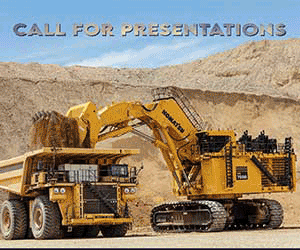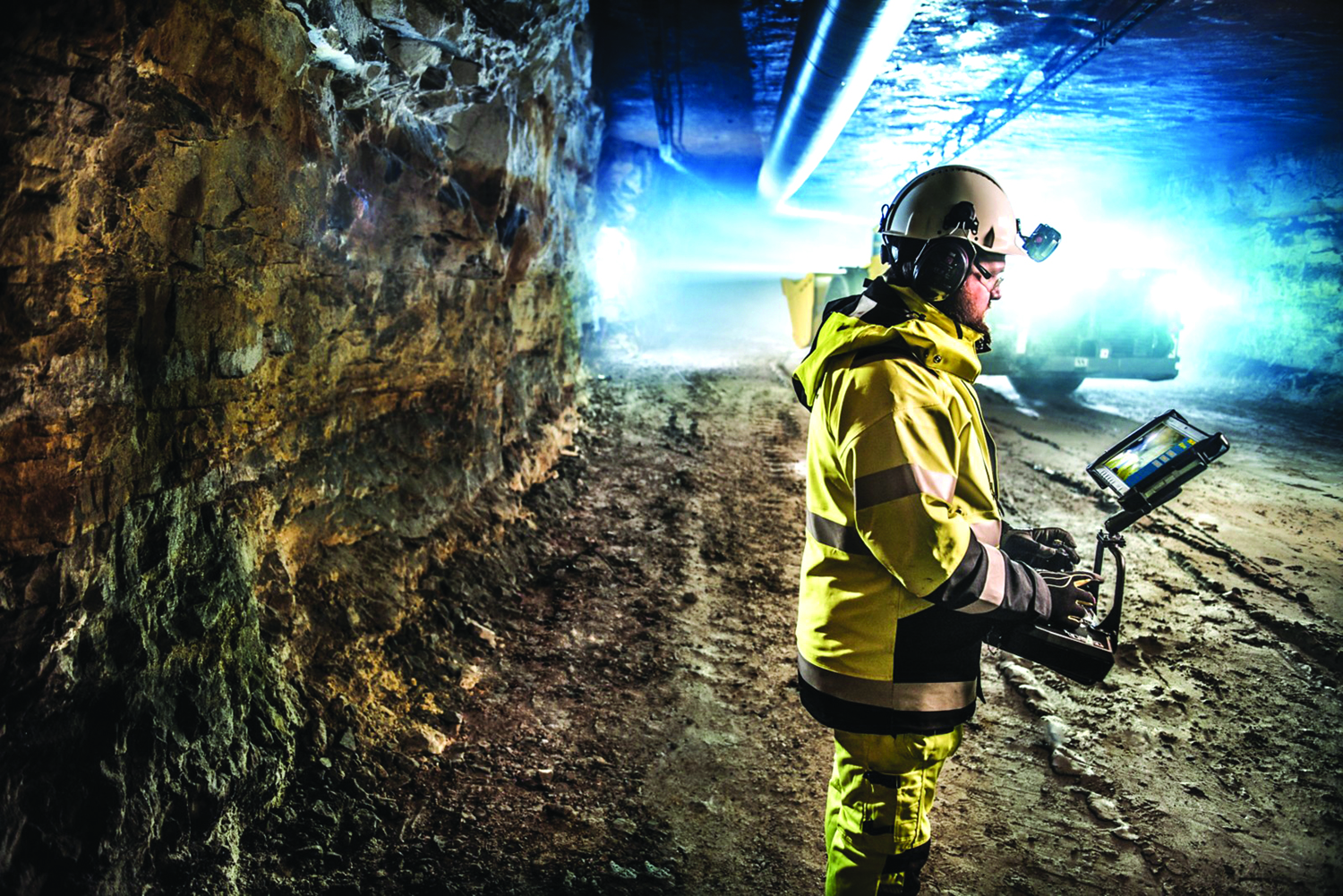
For equipment builders such as Epiroc, machines that offer line-of-sight operations with radio remote control are seen as an effective solution that prevents operators from being exposed to certain safety risks. The next step: video assist, as shown here, which gives the remote operator a better view of the loading process.
There’s no one-size-fits-all answer for improving mine worker safety, but an expanding array of possible solutions makes it easier to tailor a program for success
By Russell A. Carter, Contributing Editor
Decisions and outcomes in the mining industry are mostly shaped by the laws of science, mathematics or supply and demand, but when it comes to safety and health issues, those ironclad laws and proven principles have to share space with the fuzzy science of human behavior. As an industry that involves large, diverse work groups and a constant flow of contractor and vendor personnel on site, the expanding scope of health and safety concerns might present mining companies with a prospect similar to switching from a game of checkers with a familiar adversary to 3D chess with a constantly changing lineup of opponents.
One of the principal challenges in this environment is to identify the factors that actually affect worker-safety compliance and performance. A 2020 survey by the U.S. government’s National Institute for Occupational Safety and Health (NIOSH) looked at this issue by ranking the relative importance of various safety “constructs” — the term for a research concept and tool that measures a characteristic or trait — in determining the most significant worker influences on health and safety (H&S) as defined by worker proactivity, compliance, and reported near-misses or other incidents. The constructs included four of a personal nature (risk tolerance, thoroughness, sense of control and adaptability) and six that were organizational (organizational support, supervisor support, supervisor communication, coworker communication, worker engagement and training).
The study, which involved more than 2,600 workers at 39 mine sites throughout 17 states, produced some interesting results. According to the authors, while all 10 constructs were meaningful predictors of compliance, workers’ risk tolerance was a predominant factor, followed by workers’ thoroughness and coworker communication. H&S training and organizational support were statistically significant but less important as influencing factors. These results, according to the authors, indicated, first, the prime status that personal constructs possess in predicting workers’ H&S performance; and second, the value organizations could gain from accounting for and addressing both organizational and personal factors where possible.
Through identifying and describing the potential impact that both personal and organizational indicators have on H&S compliance and performance, the authors suggested their report could provide general guidance that organizations may use to begin addressing selected H&S practices and, over time, scale their systems to include additional indicators. In addition, they mentioned certain areas of focus that could be used to develop or enhance various workplace safety initiatives that encourage personal responsibility. Some of these, in no particular order of importance, include:
• Recognizing that risk tolerance among workers is a trait that can be changed over time. Consequently, employers should work toward improving workers’ decision-making capabilities.
• Taking a second look at current training practices and how much they focus on improving workers’ opportunities and involvement regarding their roles in work processes and practices.
• Enhancing worker engagement opportunities. The report provided examples that have been successful, such as allowing workers to choose a new type of personal protective equipment (PPE) based on a variety of approved options; involving workers on various health and safety committees, including participation in walk-throughs and debriefs on-site; and improving communication quantity and quality throughout the workday.
Powering Up for Data Delivery
There’s no shortage of recommendations — online, in research literature, or from consultancy sources — for addressing mine safety issues. As might be expected from recent industry trends, many of these suggestions are geared toward increased data collection and analysis. A critical factor in maintaining continuity in data flow is power grid reliability. The industry’s needs for digital solutions in this area haven’t escaped the notice of multinational, multisegmented companies like Hitachi, which purchased an 80.1% share of ABB’s Power Grids business in 2020. The acquisition, now known as Hitachi ABB Power Grids, provides an avenue for Hitachi to combine the power grids business with its digital technologies for expanded market opportunities.
One of the industrial areas the new entity is focused on is mining. Earlier this year, the company said it successfully deployed the first microgrid solution in Indonesia, ensuring a continuous power supply for off-grid mining operations at the Indominco Mandiri coal mine in Bontang, East Kalimantan. The solar-powered microgrid makes use of Hitachi ABB Power Grids’ Advanced Controls to maximize system performance, using Hitachi’s e-mesh solution to ensure stable, coordinated operation of the new PowerStore Battery Energy Storage System (BESS) and solar PV with existing power plants. During the day, the BESS smooths out fluctuations from the renewable generation and uses load sharing to ensure efficient operation of system gensets. It also supports network frequency, providing stability to the mining operations. The PowerStore, in addition to constantly monitoring power operations for issues, can quickly dispatch BESS when it’s needed to protect Bontang’e electrical network.
E&MJ spoke with Bryan Friehauf, senior vice president of enterprise software solutions, at Hitachi ABB Power Grids, and Jason Hartley, senior vice president of customer success, to get a better idea of how the company’s capabilities can be leveraged beyond power-grid operations to improve mine safety. Friehauf pointed out that Hitachi ABB Power Grids has access to many years of expertise and experience through ABB’s installation base of both electrical distribution equipment and plant control systems. “Combine that with our software solutions and we have the capability to provide IT and OT tools to operators through a single plane of glass, so to speak — a convergence that provides a higher degree of situational awareness of asset status.”
“That convergence allows us to place critical asset information not just in the hands of control room staff, but also into the hands of on-site workers through mobile devices,” Hartley added. “If something has to occur before a worker can safely enter a location, like de-energizing a machine or closing a valve, they can be sure it’s been done by checking their handheld and not just relying on the control room. The safety factor also extends to knowing beforehand if a machine or system is showing signs of malfunction, say, overheating or overpressure. The worker can be warned to not approach until the risk has been reduced or eliminated.”
Higher worker efficiency also can play into a safety scenario: “Through better information transfer, worker training and qualifications can be checked before they’re assigned to a task, so you don’t just have an operator trying to handle a job that requires specialized training or experience,” Friehauf said. “And, quick access to parts inventory data means that once they’re at the site, they don’t need to search around for parts location or installation instructions, they can get that information on a handheld or wear a video headset to display and receive whatever information is needed.”
Advanced visualization capabilities made possible through enhanced network performance and other digital solutions also can contribute to improving safety in an industry workforce that’s changing — older employees are retiring, taking with them the knowledge and skills acquired through years on the job; while more contractors are appearing on site, working in locations or on equipment that they may not be totally familiar with. Moving beyond the concept of digital-twin models that is increasingly being used to improve mine-system design and performance, Friehauf envisages “operational” virtual twin models that show not just a digital rendering of assets, but also include as much physical, sensory information about an asset as possible.
“This would provide the ability to use the virtual model as a training tool — overlaying the real with the digital and incorporating step-by-step guided assistance to make sure the worker is following procedure” — either in a realistic simulation session or an actual repair assignment, he explained. “This type of technology is what will be needed to extend the skills and experience of older workers to new hires entering the workforce.”
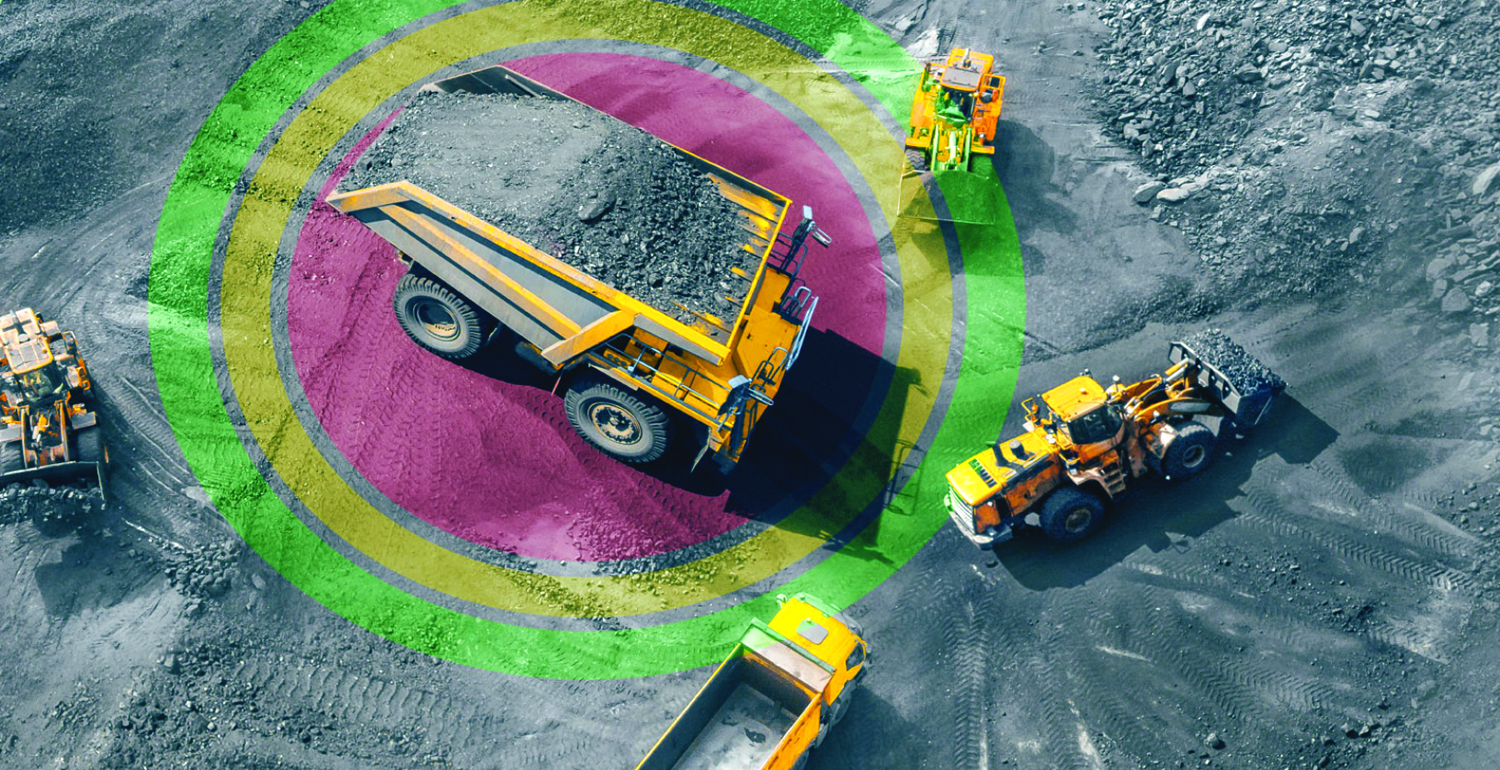
VIA Technologies introduces its new Mobile360 M810 DOD (Dynamic Object Detection) system at the recent CIM Virtual Convention and Expo, with features that include 360° visual monitoring around equipment, advanced radar detection of safety hazards, and customizable sound alerts.
Safe Design: First in Line?
Big safety problems can represent tantalizing opportunities for Big Data solutions. But, before companies contemplate using data as their primary tool for safety improvement, a more basic first step is often recommended: eliminating hazards in equipment, structures or processes during the design process. Safe design involves integrating hazard identification and risk assessment methods early in the design process, to eliminate or minimize risks of injury throughout the life of a product.
In the field or in the plant, fixed-base machinery with external movable parts, such as conveyors, often are the focus of safety efforts because of their high rate of involvement in safety incidents. As the article from Martin Engineering explained, safety and reliability — and a corresponding decrease in risk exposure for maintenance crews — can be incorporated into new or existing conveyor systems by utilizing Hierarchy of Control methods for alleviating hazards, with safe design considerations vital for minimizing safety risks.
The Hierarchy of Controls concept (elimination, substitution, separation, engineering, administrative, personal protective equipment) is now accepted throughout the industry, with leading producers such as BHP making it a foundational element in their safety risk management efforts involving everything from design and construction of new facilities to changes in existing operations and the design, planning, scheduling and execution of work. BHP also actively encourages innovation from its suppliers to bolster the company’s safety capabilities. For example, maintainers at BHP Mitsubishi Alliance’s (BMA) Caval Ridge mine wash plant will no longer be exposed to rotating machinery during filter press repairs because of a solution developed through BHP’s Supplier Innovation Program.
BHP launched that program in mid-2020 to make it easier for companies from the Mining Equipment, Technology & Services (METS) sector to work with BHP, while providing access to a broader range of unique and innovative solutions to business problems. The program is in partnership with METS representative body Austmine and follows a model that has operated successfully in BHP’s Minerals Americas business for the last decade.
The maintenance team at Caval Ridge used the program to help find a safer way to perform maintenance on the filter presses that remove moisture from coal rejects at the wash plant. BHP said the challenge drew interest from 235 suppliers across Australia, with 21 providing Expressions of Interest (EOIs). Through a series of interactive online workshops with representatives from the vendors, Caval Ridge, the Procurement Partners Innovation team and Austmine, nine companies were short-listed to present formal proposals.
In January, Australian-owned Jord International was awarded a contract to work with the maintenance team at Caval Ridge to pilot their solution. Jord’s solution comprises a belt cartridge installer within a self-contained steel frame that holds a new belt and removes the old, damaged belt. The first belt installer will go into service by July, and run for six months. If successful, the new approach will be implemented permanently at Caval Ridge, and potentially at other BMA sites.
James Agar, group procurement officer, said the Supplier Innovation Program enables BHP to crowd-source a broader range of unique and innovative solutions to business challenges. “With filter press belt replacements, it is a time-consuming task with lots of manual handling. While there are processes in place to control the risks around that task, the new solution proposed through this innovation program eliminates the need for maintainers to be in physical contact with the filter press altogether,’’ James said.
Make Management Part of the Solution
Scott Gaddis, vice president and global practice leader for environment, safety and health at environmental health and safety quality software developer Intelex, wrote in a blog post for the American Society of Safety Professionals that even companies with the best safety-culture intentions sometimes fail to achieve satisfactory results because of a misdirected point of view. Focusing exclusively on compliance and mistaking compliance for culture are common mistakes; another is assuming that safety culture originates in the front lines of the job force, rather than recognizing that management is instrumental in fostering culture as well. (See Formula for Effective Safety Management: Observe, Plan, Do, Check, for a safety management consultant’s view of the industry.)
Severstal, the vertically integrated steel producer, which operates four large mines in Russia, is just one of many companies expanding the role and responsibilities of managers in safety initiatives. It announced in April it will start disclosing data on industrial injury rates (LTIFR) for contractors working at the company’s production sites, and contractor safety targets will also be included within the personal KPIs of top management from 2021. The company said the annual remuneration of a number of senior employees, including the CEO, is directly linked to occupational safety performance.
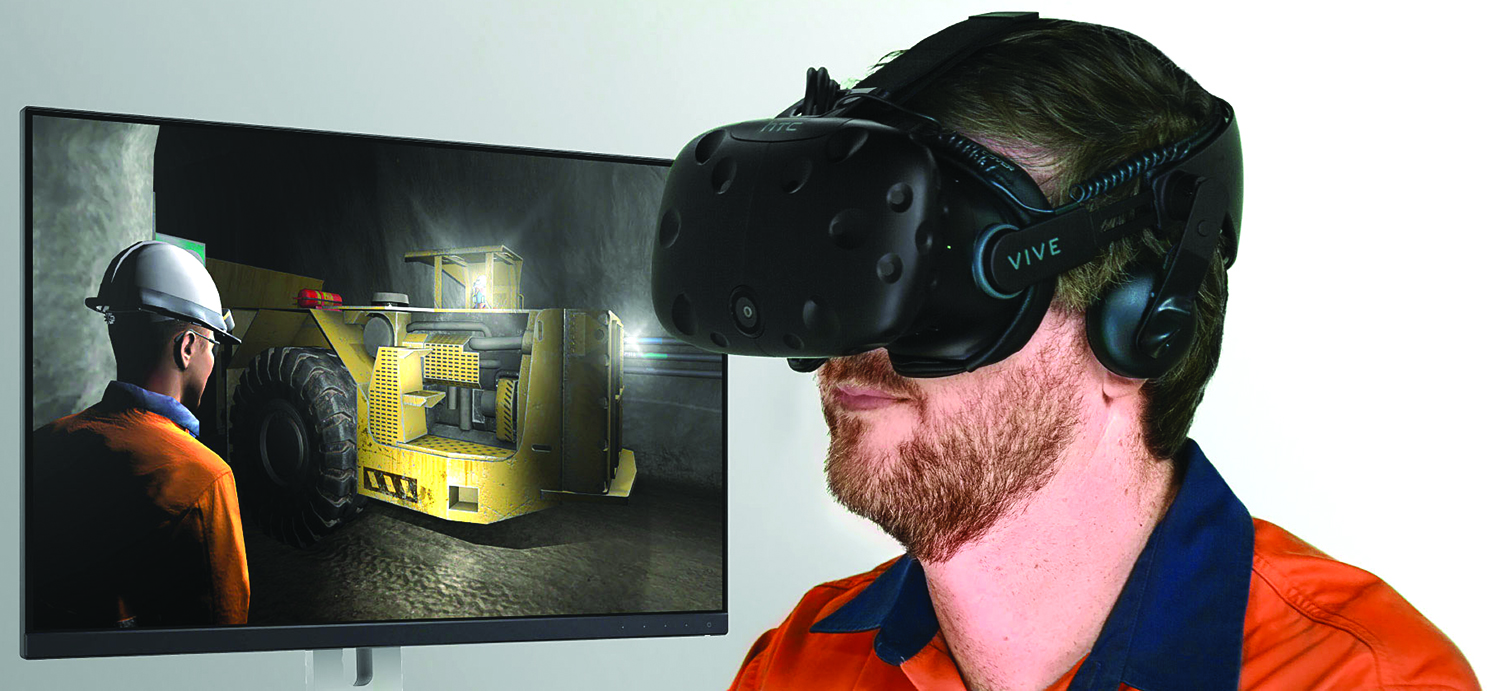
Immersive Technology’s Mine Standards Training system for supervisory safety development offers users a choice of operating in Virtual Reality via the company’s existing Worksite VR Quest platform, shown here, or on an interactive classroom touchscreen.
Companies interested in supervisory improvement may benefit from Mine Standards Training, a product recently introduced by equipment simulator developer Immersive Technologies. MST is designed to impart a deeper understanding of potential accident-causing scenarios for front-line supervisors, according to the company, which said that focus on improving the supervision and coaching of heavy equipment operators via improvement of supervisor proficiency led to its development. “Gone are the days where it takes a full year for a supervisor to be exposed to all types of weather, traffic, loading and digging conditions. This exposure and skills development can now be accomplished by immersing the learner into a replicated 3D mining environment through VR and touchscreen technology,” said Cian Dobson, visual database manager at Immersive.
The company described MTS as “dynamic, offering users the option to operate in Virtual Reality via our existing Worksite VR Quest platform, or on an interactive classroom touchscreen. These two options leverage current simulation assets to create engaging content such as drilling and blasting, ground engagement tools, supervisor training, pit priority rules, and many more related situations.”
“Imagine being able to simulate a scenario from surface or underground operations, put it on a virtual table and walk around it. Now add the capability to view the process from the cabin of any machine, or teleport to the pit floor itself. Then, take this scene and insert visual cues a supervisor should be able to identify, assess and correct. Sometimes these cues are subtle and sometimes obvious. Some are visible immediately; some are only clear at various times of the day or from a certain vantage point.”
Dobson said the system would help supervisors “create realistic simulations in Mine Standards Training of both perfect and flawed operator behavior requiring the user to identify the deviations from best practices. This capability is helping transform existing flat content training programs to ones that are engaging and have higher levels of learner engagement and knowledge retention. The content is highly realistic and will improve the learning experience for both experienced and inexperienced users.”
Technology Can Help
The variety, capability and availability of technological solutions that can be applied to identify and possibly solve worker-safety issues continues to grow. Product and application concepts that once were regarded as beyond state of the art are now showing up in the workplace as everyday tools for work and information sharing.
For example, Hexagon, a developer of sensor, software and autonomous solutions, reported that its workshop technicians are using Smith Optics safety glasses with Google Glass Enterprise Edition to support hardware repairs in local offices from Almaty, Kazakhstan to Brisbane and Perth, Australia, to Balikpapan, Indonesia. This approach, according to the company, has in many cases reduced hardware repair and return times, lowered costs, enabled the sharing and capturing of implicit knowledge in a corporate repository, and ultimately improved the customer experience. Post-pandemic, Hexagon said it will continue to refine and improve this work method.
Vuzix Corp. recently announced that Rio Tinto has deployed its Smart Glasses at the Oyu Tolgoi mine in Mongolia, enabling technical experts at other locations to remotely work with local teams on the mine site. And last year, Beumer Group, a material-handling systems supplier, announced the availability of its own Smart Glasses, designed to allow office-based company technicians to “look over the shoulder” of workers on-site to assess equipment problems. As explained by Christopher Kirsch, team leader for the project, said, “The employee at the machine puts on the glasses and starts the Beumer support app via voice command. The employee transmits a service number and a pin code to the hotline, and the connection with image and sound is established. The Beumer technician receives the same image as the customer. The technician can directly give instructions and display all relevant information in the field of vision. The employee has both hands free to follow the instructions of the expert and carry out the necessary actions.”
Diversified minerals producer Teck said it has completed a pilot project that used an innovative combination of on-the-ground data and video technology developed by Nanozen Industries to help understand potentially harmful dust exposures at a task level in order to closely focus critical control strategies. Nanozen is a Vancouver, Canada-based company that pursues innovative approaches to aerosol exposure analysis for industrial workplace environments. The project included Teck’s Greenhills, Fording River, and Highland Valley Copper operations.
Teck explained that it’s been standard industry procedure for years to rely on daily sampling methods, averaged over the length of a shift, to determine dust exposure, but these sampling methods provide only one value indicating an employee’s overall dust exposure for a shift. By making use of Nanozen’s real-time monitoring technology, Teck said it was able to greatly improve the collection of information about dust levels during a work shift. Instead of a single value for an entire shift, the company can now monitor live, accurate information on dust exposures, enabling it to better understand how and when these exposures occur and to target controls that reduce exposures from higher-risk activities.
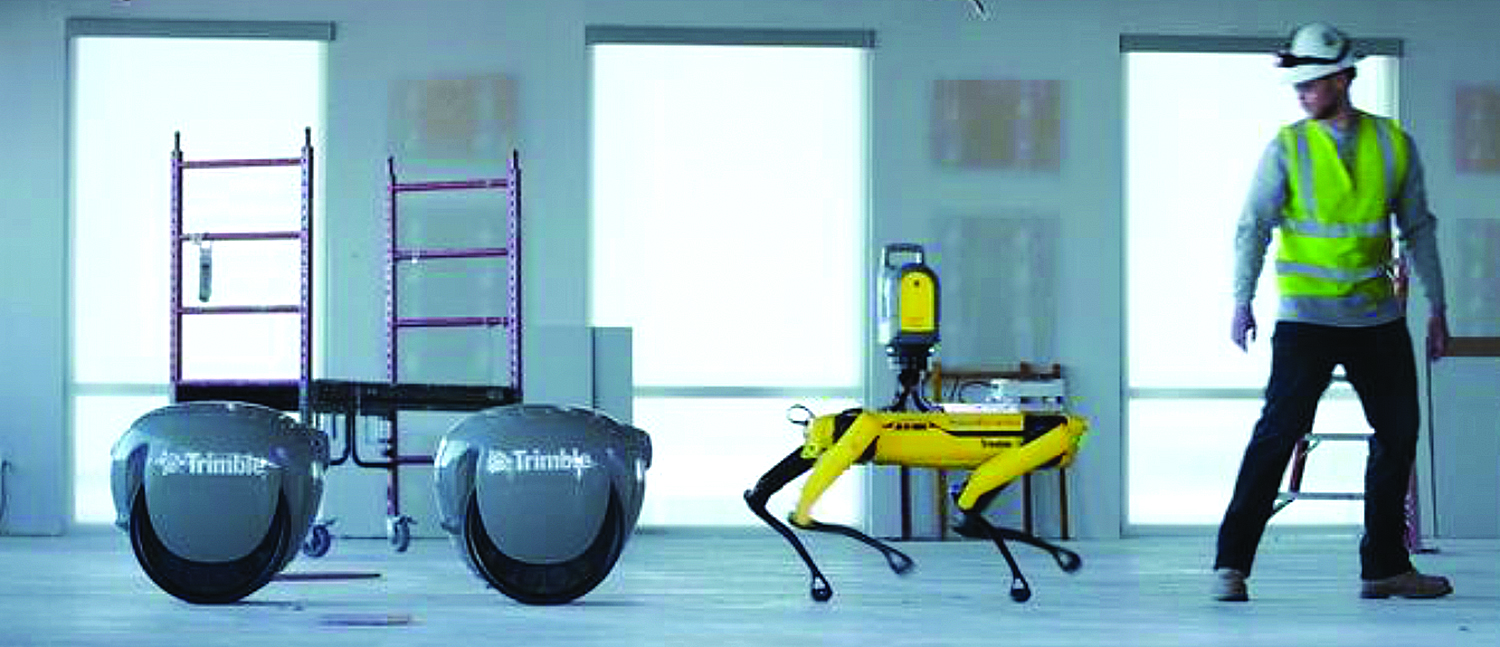
The PFFtag concept, developed using ‘smart follow’ techology, is designed to enable robots to follow humans autonomously. Safety benefits could include taking on the burden of heavy equipment normally carried by a worker to a job location.
Other potentially safety-related solutions coming through the technology pipeline were once considered science-fiction fantasies but are now promising prototypes undergoing field testing. For instance, Piaggio Fast Forward (PFF), a subsidiary of the Piaggio Group, and positioning-system specialist Trimble reported recently on a proof-of-concept collaboration to enable mobile robots and machines to follow humans and other machines in industrial applications. Together, the companies have integrated a “smart following” module prototype developed by Piaggio Fast Forward on to a Boston Dynamics’ Spot robot platform controlled by Trimble’s advanced positioning technology.
The technology, called PFFtag, could be accessed by business partners to leverage its exclusive algorithms and their own software, enabling a human to control a robot via pairing and improving its ability to sense direction and velocity as it follows the leader. A push of a button activates a fused sensor array that pairs to a leader who navigates Spot or another robot or machine in dynamic environments, without special training, joystick, app or tablet. Ultimately, said the project partners, this can create a wider range of applications for existing machines and positively impact productivity, safety and quality of work.
Trimble conducted testing using a Spot robot equipped with Trimble laser scanning or Global Navigation Satellite System (GNSS) sensors and PFFtag technology at one of its customer’s sites in Colorado over the course of two months. Aviad Almagor, division vice president, Trimble Emerging Technologies, said the technology may have the future ability to assist field personnel in their daily activities by carrying heavy equipment, improving efficiency and enhancing worker safety.
Integration is Key
While safe design is an excellent first step for eliminating safety incidents before they can occur, a recent article published by Deloitte highlights the advantages of using predictive data analysis to go one step farther by enabling companies to surpass simple analysis of past events and identify potential future scenarios that create a higher risk of an incident occurring.
The key to success in this effort is integration, as the authors explained: “One of the sticking points for advanced analytics… involves aggregating the right data. Many companies have learned the hard way that simply collecting massive amounts of safety data is insufficient. Most mining companies have in-depth reports tracking the number of worker injuries sustained, the frequency rate of safety incidents, and many other metrics. But this data is all collected after the fact.”
Companies serious about monitoring conditions to proactively prevent incidents need greater insight into the circumstances and drivers of those incidents. However, many companies struggle to access this level of data. That’s partly because it often resides in disconnected systems. “As mining companies move toward integrated nerve centers and begin to build enterprise-wide data lakes, they’ll be able to harness the data necessary to run advanced predictive models,” explained Shak Parran, partner, consulting, Deloitte Canada and co-author of the February 2021 report, On the Road to Zero Harm: Creating the next generation of integrated predictive safety systems, along with Gerhard Prinsloo.
By allowing companies to combine vast amounts of data, rather than viewing each in isolation, an integrated approach can help them uncover hidden patterns of behavior or conditions that contribute to incidents. At the same time, predictive models can position them to target high-risk operational scenarios and employee groups in order to intervene before these incidents occur.
The authors asserted that real insight into solving safety problems hinges on mature data governance, with mining companies perhaps appointing chief data officers or other executives responsible for establishing data standards across the organization. Turning the potential for a zero-harm future into reality may also require mining companies to look beyond their own internal data sources.
“To successfully predict the risk level of activities, many disparate data sources are required — sometimes even from several companies,” Parran noted. “This underscores the need for greater cross-industry collaboration.”
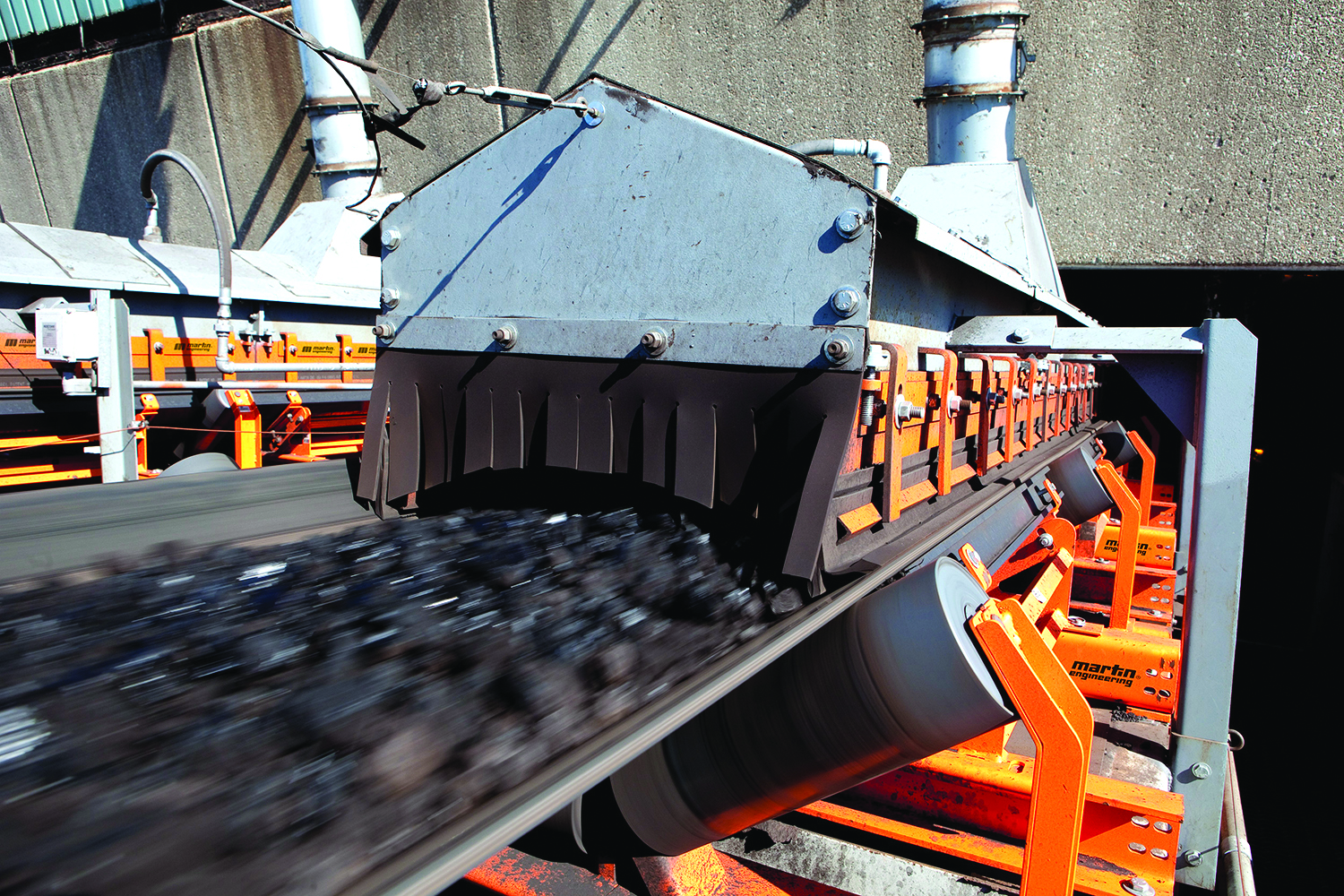 Engineering Safer Conveyors
Engineering Safer Conveyors
Bulk materials handling solutions provider Martin Engineering noted that all new conveyor systems will inevitably succumb to their punishing environment and begin the slow process of degradation. The system will eventually require more time and labor for maintenance, shorter spans between outages, longer periods of downtime and an ever-increasing cost of operation. This period is also accompanied by an increased chance of injury or fatality as workers are progressively exposed to the equipment to perform cleaning, maintenance and to fabricate short-term fixes to long-term problems. A total system replacement is cost prohibitive, according to the company, but to remain compliant and/or meet ever-increasing production demands, upgrades and repairs are unavoidable.
When examining system safety, improving efficiency and reducing risk can be achieved by utilizing a hierarchy of control methods for alleviating hazards. The consensus among safety professionals is that the most effective way to mitigate risks is to design the hazard out of the component or system. This usually requires higher initial capital investment than short-term fixes but yields more cost-effective and durable results.
Hierarchy of Control Methods
A look at the U.S. Occupational Safety and Health Administration (OSHA) accident database reveals the dangers of working around conveyors. Studies have shown that the highest prevalence of accidents are near locations where cleaning and maintenance activities most frequently take place: take-up pulley, tail pulley and head pulley.
Designing hazards out of the system means alleviating causes with the intent to bolster safety on a conveyor system, but the methods of protecting workers can vary greatly. In many cases, it will be necessary to use more than one control method, by incorporating lower-ranked controls. Some lower-ranking approaches do not remove the source of hazards and are best considered as support measures, rather than solutions in and of themselves. The components of safe design include:
PPE – designed to provide a barrier between the wearer and the hazard. Downsides are that they can be worn improperly, may be uncomfortable to use through an entire shift, can be difficult to monitor and offer a false sense of security and they do not address the source of the problem.
Administrative Controls – changes to the way people work create policy that articulates a commitment to safety, but written guidelines can be easily shelved and forgotten. These controls can be taken a step further by establishing “active” procedures to minimize the risks. For example, supervisors can schedule shifts that limit exposure and require more training for personnel, but these positive steps still do not remove the exposure and causes of hazards.
Warning Signage – generally required by law, so this is less of a method than a compliance issue. Like other lower-tier methods, signs do not remove the hazard and are easily ignored.
Engineering Controls – allow remote monitoring and control of equipment or are designed to obstruct access; these can reduce exposure, but again, do not remove the hazard.
Substitute – replaces something that produces a hazard with equipment or materials that eliminate the hazard. For example, manual clearing of a clogged hopper could be replaced by installing remotely triggered air cannons.
Eliminate by Design – incorporates features such as longer, taller, tightly sealed loading chutes to control dust and spillage or heavy-duty primary and secondary cleaners to minimize carryback. By using hazard identification and risk-assessment methods early in the design process, engineers can create the safest, most efficient system for the space, budget and application.
Prevention Through Design (PtD)
Another way of saying “Eliminate by Design” is PtD (Prevention through Design), the term used by The National Institute of Occupational Safety and Health (NIOSH), which spearheaded the PtD initiative. In its report, NIOSH pointed out that, while the underlying causes vary, studies of workplace accidents implicate system design in 37% of job-related fatalities.
Cost is most often the main inhibitor to PtD, which is why it’s best to implement safer designs in the planning and initial construction stages, rather than retrofitting the system later. The added engineering cost of PtD is often less than an additional 10% of engineering, but has enormous benefits in improved safety and increased productivity. The cost of PtD initiatives after initial construction can be three to five times as much as when the improvement is incorporated in the design stage. The biggest cause of expensive retroactive improvements is cutting corners initially by seeking lowest-bid contracts.
Although the policy is generally not explicitly stated by companies, the low-bid process is usually an implied rule that is baked into a company’s culture. It encourages bidders to follow a belt conveyor design methodology that is based on getting the maximum load on the conveyor belt and the minimum compliance with regulations using the lowest price materials, components and manufacturing processes available. But when companies buy on price, the benefits are often short-lived, and costs increase over time, eventually resulting in losses. In contrast, when purchases are made based on lowest long-term cost (life-cycle cost), benefits usually continue to accrue and costs are lower, resulting in a net savings over time.
Rather than meeting minimum compliance standards, the conveyor system should exceed all code, safety and regulatory requirements using global best practices. By designing the system to minimize risk and the escape and accumulation of fugitive material, the workplace is made safer, and the equipment is easier to maintain.
Life-cycle costing should play into all component decisions. Buying on Life Cycle Cost and anticipating the future use of problem-solving components in the basic configuration of the conveyor provides improved safety and access, without increasing the structural steel requirements or significantly increasing the overall price. It also raises the possibility for easier system upgrades in the future.
The “Evolved Basic Conveyor”
Using the Hierarchy of Controls along with the Design Hierarchy, engineers will be able to construct an “Evolved Basic Conveyor” that meets the needs of modern production and safety demands. Built competitively with a few modifications in critical areas, an Evolved Basic Conveyor is a standard, bulk material-handling conveyor designed to allow easy retrofitting of new components that improve operation and safety, solving or preventing common maintenance problems.
Installing or providing for maintenance-minded solutions in the loading zone can greatly improve safety and reduce man-hours and downtime. These components include slide-in/slide-out idlers, impact cradles and support cradles. On larger conveyors, maintenance aids such as overhead monorails or jib cranes assist in the movement and replacement of components. Also, designers should ensure adequate access to utilities — typically electricity and/or compressed air — to facilitate maintenance and performance. Next-generation conveyor designs may even feature a specially engineered idler capped with an independent power generator that uses the conveyor’s movement to generate power for a wide array of autonomous equipment.
Dust, spillage and belt tracking are top concerns for many safety professionals. Field tests have shown that enlarged skirtboards and engineered settling zones promote dust settling and reduce fugitive material. Curved loading and discharge chutes control the cargo transfer for centered placement and reduced turbulence. As the load is centered on the belt, guides ensure even travel through the take-up to promote consistent belt tracking.
Any transfer point is prone to buildup and clogging under the right conditions, be it ambient humidity, material wetness, volume or surface grade. Flow aids such as vibrators or air cannons on chutes can sustain material movement, improve equipment life, and reduce the safety hazards associated with manually clearing clogs.
Formula for Effective Safety Management: Observe, Plan, Do, Check
Paul Balmert is a veteran safety management educator and founder of Balmert Consulting, a group of safety professionals focused on improving operations execution and management effectiveness. He authored the best-selling book Alive and Well at the End of the Day: A Supervisor’s Guide to Managing Safety in Operations. E&MJ asked for his thoughts on some topics of interest regarding safety leadership practices.
E&MJ: Does every company need a safety management system? Should the system shape the company’s culture or vice versa?
Every organization has a culture, but what does that really mean? My take on culture is totally pragmatic: It is simply “what most people do, most of the time.” If you want to know what the culture is in any organization, just look at how workers park in the lot; the condition of production equipment; how well rules are followed; level of compliance with near-miss reporting, and what happens then; how long does it take to get something fixed?
How do leaders, managers and supervisors, usually behave on matters involving safety? It’s easy to determine by observation. I point that out because creating a management system for safety is, first and foremost, an effort directed at governing how leaders manage safety.
As to the basic elements of a management system, for safety or for any business function, they’re traceable to Deming’s Virtuous Cycle: Plan/Do/Check/Act. In practice, the power of a management system is found in a simple step called “Do.” It’s what’s done that determines the outcome. Planning helps, and so does Checking, but Doing — execution — is the name of the game.
Now, should the system shape the culture, or should it be the other way around? I think the answer rests with the executives who own the system. If they’re happy with the way things are —what most leaders do most of the time — the best answer is to leave well enough alone. “Just write down what we do, and let’s call that our system.” Because it is.
If things could be better — management processes or performance or both — identify the processes in need of improvement. Then, design them the way you want them to be. If better safety performance is the end game, be sure any changes will lead to that result.
That’s the Plan step. Plans have to be converted into doing. That’s the point where the management system takes on the management culture and either succeeds or fails.
E&MJ: How practical and applicable is Predictive Analytics to safety and health management?
In safety parlance, you’re describing what’s known as Leading Indicators. Many operations use safety performance metrics to predict future performance, but the predictive capability of most leading indicators is debatable. My favorite example: What does a spike in near-miss reports really portend?
The use of data to manage safety performance has lagged far behind most business functions. Could the tools of Predictive Analytics raise the safety performance metrics to the level of measurement science routinely used by all the other business functions? Absolutely! The practical problem in making that happen is the relative absence of safety data. With the possible exception of behavioral safety observation programs, most organizations don’t collect much data about safety performance.
I can’t forecast the future, but if Predictive Analytics became the catalyst to bring the data revolution to safety, it would be a great thing for everyone in the business.
E&MJ: Some organizations are taking a more holistic approach to worker health and safety. Do you see the mining industry moving in this direction?
Many factors impact the safety of everyone who works for a living, and the items on that list don’t begin at the start of the shift and end when people head home. Matters such as fitness for duty, adequate rest, family needs and problems, and stress can — and do — play a role in working safely or getting hurt. If the goal of zero injuries is to be achieved, those factors can’t be ignored. But they’re not easily managed.
You can point to the pandemic to illustrate the point. In the last year, industrial leaders have been grappling with the challenges of the pandemic. It’s been brutally tough on everyone; balancing what goes on at work with what’s going on at home has been a major source of stress. I give leaders huge credit for paying attention to those issues: I’ve been amazed and impressed at how well so many have managed the challenge for their followers — all the while managing the challenges going on in their own lives. On that point, leaders are no different than their followers.
E&MJ: Can equipment such as Smart PPE replace or reduce the importance of worker/management judgement and personal responsibility?
Managing safety technology well is one of the many tough safety challenges executives have to contend with. Technology has made the world a far safer place to live and work. What manager wouldn’t want to invest in technology if it makes the job safer for those doing the work?
But, no matter how good the technology and equipment, there’s no getting around the fact that people still need leadership if they are to work safely. Smart PPE needs to be worn, doesn’t it? I’ve yet to meet an industrial leader — and I’ve met tens of thousands of good leaders the world over — who said, “PPE compliance is never a problem for my crew.” That’s reality.
Bottom line: Yes, a leader needs to invest in technology wisely, but when it comes to sending everyone home alive and well at the end of the day, there is no substitute for safety leadership. I don’t think that will ever change.





